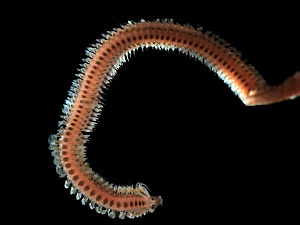Phyllodoce mucosa
| Phyllodoce mucosa | ||||||||||||
|---|---|---|---|---|---|---|---|---|---|---|---|---|

Phyllodoce mucosa |
||||||||||||
| Systematics | ||||||||||||
|
||||||||||||
| Scientific name | ||||||||||||
| Phyllodoce mucosa | ||||||||||||
| Örsted , 1843 |
Phyllodoce mucosa is the name of a marine striped worm from the family of Phyllodocidae within the class of polychaete (Polychaeta), in seas of the Northern Hemisphere is widespread and mainly as scavengers fed.
features
Phyllodoce mucosa has a slender body up to 15 cm long with around 275 segments , which gradually decreases in width in the rear half of the body. The prostomium is rounded and rectangular. The eyes are medium in size. The proboscis has in its proximal section 12 - 6 on each side - longitudinal rows of 9 to 10 papillae, in the distal section 6 rows of more or less distinct nodules. The end ring has 16 to 17 papillae. The 1st segment cannot be seen from above and has two tentacles - cirrus - that extend approximately to the 6th segment. The dorsal tentacle cirrus of the 2nd segment extend approximately to the 10th segment, the ventral tentacle cirrus to approximately the 6th segment. The dorsal tentacle cirrus of the 3rd segment extends approximately to the 10th segment. Bristles are present from the 3rd segment. The dorsal cirrus of the middle segments are rectangular, the lobes of the parapodia are rounded. The ventral cirrus is pointed and somewhat longer than the lobes of the parapodia. The cirrus pygidium is six times as long as it is wide.
The prostomium has a noticeable dark pigmentation in front of the eyes, and the 1st segment, which is only visible from below, is also darkly pigmented. The 2nd and 3rd segments are dorsally and ventrally unpigmented or only slightly pigmented. From the 3rd segment on there are three dark spots centered around the areas of the back that appear to be segmented within each segment. Further back, the spots can be fused and form a more or less continuous longitudinal band. There are further pigmentations at the base of the parapodia, on the cirrus carriers of the dorsal cirrus and in the middle of the dorsal cirrus. The ventral pigmentation is much less evident, with one spot - occasionally two - in the center of each segment and at the base of each parapodium. There is a yellow pigment dorsally on the posterior portion of the prostomium and on the anterior portion of the 2nd segment. On the posterior segments there are two small yellow spots dorsally per segment. The eyes are dark reddish brown. In preserved animals, the dark pigmentation is usually well preserved, while the yellow disappears.
distribution and habitat
Phyllodoce mucosa is found in the Arctic , the northern Pacific Ocean , the northern Atlantic Ocean to the coast of West Africa and the Gulf of Mexico , the Mediterranean , Adriatic Sea , Black Sea , Red Sea , the English Channel , the North Sea , in the Skagerrak , Kattegat , the Great and Little Belt , the Oresund and the Bay of Kiel . Due to their great similarity, especially with Phyllodoce maculata , a reliable determination and therefore the delimitation of the distribution area is difficult.
habitat
Phyllodoce mucosa lives on sandy and muddy subsoil, but also on gravel and sand in the intertidal zone down to a depth of about 20 m.
Development cycle
Phyllodoce mucosa is separated from the sexes and forms swarms on the surface of the seabed when mating, with several males swarming around a female without changing shape. The egg cells are fertilized in the open sea. A female's green, gelatinous egg clutches can contain over 10,000 eggs and are attached to large brown algae . The larvae develop through two free-floating Trochophora - and two Metatrochophora stadiums before they can be prepared according to sink down to nine weeks to crawling worms metamorphose .
Food and protection from enemies
As a scavenger, Phyllodoce mucosa feeds on the flesh of dead animals such as dead molluscs, crabs and polychaetes, the smell of which they are attracted to in large numbers when the tide is out at night . The necrophage polychaet crawls on a track of mucus and devours up to a third of its body weight during a meal on a carcass. Although the animal has no jaws or teeth, it can tear pieces of meat on the carcass with its evertable, muscular pharynx . After the meal is finished, the annelid quickly withdraws into the sediment. Phyllodoce mucosa also protects itself against predators with its bad-tasting mucus.
literature
- Gesa Hartmann-Schröder (1996): Annelida, Borstenwürmer, Polychaeta. Tierwelt Deutschlands 58, pp. 1–648, here p. 529, Phyllodoce .
- John D. Fish, Susan Fish: A Student's Guide to the Seashore . Cambridge University Press, Cambridge 2011. 540 pages. Phyllodoce mucosa (Linnaeus) , p. 166.
- C.-G. Lee, M. Huettel, J.-S. Hong, K. Reise (2004): Mucus enhances mobility. Carrion-feeding on the sediment surface at nocturnal low tides by the polychaete Phyllodoce mucosa. Marine Biology 145 (3), pp. 575-583.
Web links
- Phyllodoce mucosa spotted leafworm , marine water lexicon
- MJ de Kluijver et al .: Phyllodoce mucosa Oersted, 1843. Macrobenthos of the North Sea - Polychaeta, Marine Species Identification Portal
- Phyllodoce mucosa . AG Benthic Organisms, Warnemünde.